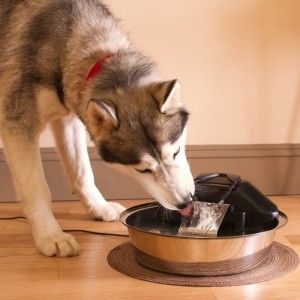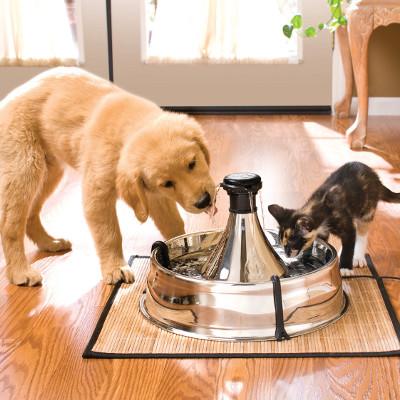By Patrick Mahaney, VMD, CVA, CVJ
Living in the perpetually sunny, hot, and dry climate of Southern California has forced me to be especially attuned to the hydration needs of my own dog, Cardiff, and my veterinary patients. I’ve witnessed the life threatening health effects caused by environmental (heat) exposure, hyperthermia (elevated body temperature), and dehydration in both dogs and cats. Therefore, I’m constantly striving to educate my clients and readers on the means to promote the best hydration of our canine and feline companions.
Why is hydration important to our pets? Water constitutes nearly 70-80% of a dog or cat’s body mass, so it’s absolutely an essential nutrient for a normally functioning body. Remarkably, a loss of only 10% of the body’s total fluids can cause serious illness. Water is vital in the process of tissue growth, healing, and recovery from activity. Lack of liquid consumption and loss of body fluid reduces overall blood volume and leads to dehydration. 
Your pet's body is between 60% and 80% water. Losing just 10% can cause serious health problems. Make sure you pet is getting enough water.
All body parts suffer when there is deficient fluid to move adequately blood through the arteries and veins and white blood cell-rich lymph in the lymphatic vessels. Thick blood and lymphatic fluid inefficiently perfuse and drain body tissue, causing lack of oxygenation and nutrient delivery and deficient immune system activity in all organ systems. Dehydration causes toxic substances (metabolic wastes, etc.) to be retained in tissues, which creates or exacerbates an ongoing state of disease.
How much water does my pet need to consume each day? For dogs, it’s a relatively simple equation. In general, your average healthy adult canine needs one (1) ounce of water per pound of body weight every 24 hours. Of course, a variety of lifestyle and health factors can cause a pooch to need more or less water.
A healthy adult cast should consume approximately the same quantity of water (in milliliters= mL) as the number of calories required per 24 hour period. Determining this amount requires consideration of the cat’s body weight (pounds), life stage, status for being sexually intact or neutered, and level of activity. It’s best to reference this Calorie Requirements for Cats chart.
What pets are in need of extra attention to hydration status? All pets need hydration, yet some need extra attention paid to the amount of water they drink or the quantity of moisture consumed in their food on a daily basis. In general, pets requiring better hydration include those that are growing (puppies and kittens), athletic, pregnant, geriatric, sick, living in in warmer or dryer climates, etc.
Pets are undergoing treatment for diseases, including kidney and liver failure, digestive tract upset (gastroenteritis, colitis, pancreatitis, etc.), cancer (especially to flush chemotherapy from the body), toxic exposure, etc. have a greater need for hydration beyond the basic requirements to sustain life.
Does the eating dry or canned food change daily water requirements? The style of food doesn’t necessarily change a dog or cat’s daily water requirements. Yet, feeding moist food is a great means of promoting your pet’s hydration so that less water needs to be consumed. Most dry pet foods contain approximately 7-12% water, so supplemental moisture will be needed to facilitate the digestive process and ensure adequate hydration levels. Conversely, most wet foods are nearly 80% water, so less additional moisture must be consumed to meet daily hydration requirements.
As I’m a traditional Chinese veterinary medicine (TCVM) practitioner, I also take into consideration the energetic qualities of different food formats. Dry food is very Yang (heating), as nearly all the moisture has been cooked out of it to create a piece of kibble that can conveniently sit in a bag or bowl for an extended time period before feeding.
Too much Yang energy can contribute to diseases associated with inflammation, such as allergic skin disease (“allergies”), inflammatory bowel disease (IBD), neurologic problems (seizures, hyperactivity, etc.), immune mediated disease (IMHA, IMTP, etc.), and even cancer. Moist foods are inherently Yin (cooling), which tends to be better tolerated by the canine and feline body and are less likely to cause severe illnesses associated with heat or cold. In general, my recommendation is that both dogs and cats should eat foods that are moist, freshly prepared, and made with human-grade ingredients (versus feed-grade ingredients, which have higher allowable levels toxins).
What are some methods owners can use to promote my pet’s best hydration? Besides feeding a moist diet, means of promoting a pet’s best hydration include:
- Always provide a clean and fresh water source. Only choose a hydration option that you would be willing to drink.
- Prevent your pet’s access to water sources potentially containing illness-inducing microorganisms or toxins. Such locations include puddles, communal water bowls (dog park, daycare, etc.), still bodies of water, Christmas tree containers, and many others.
- Use water dispensers that circulate and promote a pet’s curious interest in drinking. PetSafe’s lines of Drinkwell Fountains have features suitable for your pet’s needs and styles to best fit your home aesthetic.
- Minimize exposure to heating environments. Less time spent exposed to the extremes of sun and warmth will reduce the amount of body water lost via evaporation through the lungs, mouth, and nose, and paw pads.
- Always think ahead to avoid illnesses that cause dehydration. Taking a trip to the beach on a cloudy day may not seem like it’s well necessarily caused dehydration, but even inadvertent consumption of salt water on your dog’s favorite ball can lead to osmotic diarrhea (AKA large bowel diarrhea or colitis). I’ve discovered that the best means of preventing Cardiff from developing “beach diarrhea” is to use the Troff Hydration Pouch to “prehydrate” him before a significant amount of salt water is ingested. The gentle stream of water produced by the Troff is well accepted by Cardiff and does not cause him to gag or cough upon drinking.
- Cats can be notoriously challenging to get them to eat and drink, either during times of health or especially when illness strikes. Means of gently coercing cats into consuming more liquids include adding low sodium broth (chicken, beef, etc.) to moisten food and offering treats of frozen tuna water (puree a can of into a blender full of water, then freeze and offer as individual cubes) to lick.
Since water is such a vital component of all cells and an essential nutrient for life, it’s crucial that all had owners take proactive steps to promote hydration on a daily basis and reduce the likelihood that diseases that cause dehydration will occur.


